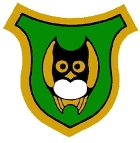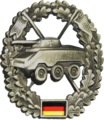Field Intelligence Force
The field Signal Corps was a branch of service in the army of the Bundeswehr . She was an element of the reconnaissance in the army. The task was the non- intelligence gathering of information by questioning and observing people . The field intelligence troops were among the army's operational and command support troops.
The field intelligence force was initially referred to as the front intelligence force after it was set up . In 2008, the field intelligence force was disbanded as an independent branch. The last major unit was the Bundeswehr Field Intelligence Center . Most of the personnel were used to set up the Army Reconnaissance Force. In the Army Reconnaissance Force, there are still a small number of field intelligence forces that operate similarly to the decommissioned field intelligence force .
assignment
The field intelligence force was an element of intelligence gathering and reconnaissance for the Bundeswehr . Unlike intelligence services which took place using the soldiers , according to service provision is not covered . The findings of the field signal corps contributed a comprehensive for the production situation picture in the case of defense and last in the foreign missions in. The aim was in particular to identify hostile intentions, deploy troops and gain knowledge of the morale of enemy armed forces or other parties to the conflict , as well as assess the mood of the civilian population in areas occupied or controlled by their own armed forces . If possible, knowledge was also gained about the mood of the civilian population in areas controlled by opposing conflict parties.
The field intelligence team used the methods of goal-oriented conversation, questioning people in the custody of the armed forces and observing objects and people. In summary, these methods are also referred to as Human Intelligence (HUMINT) ( English for "information acquisition using human sources").
The field intelligence force operated not only in secured rear areas , but also with the force close to the front edge of the defense , in order to question prisoners of war as early as possible. In the missions abroad, a certain threat potential emerged from the questioning of not always benevolent civilians.
history
The field intelligence forces emerged from the front intelligence force. The Front Intelligence Force was established as a branch of the army in 1970, but has always been one of the smallest branches of the army. In Army Structure IV , each corps was directly subordinate to an inactive or only partially active front-line intelligence company . These units were the Front News Company 100 Münster for the 1st Corps , the Front News Company 200 in Nersingen ( II. Corps ), and the Front News Training Company 300 in Diez an der Lahn ( III. Corps ). The Front Message Training Company 300 was subordinate to the Bundeswehr Intelligence School in Bad Ems as a training unit , which at that time trained the front message soldiers and was responsible for the further development of the force. In the territorial army of Army Structure IV , the three territorial commands also had one additional front message company planned as equipment units: Front message company 600 in Neumünster , front message company 800 in Düsseldorf and front message company 850 in Oftersheim .
Most of these companies were disbanded after the Cold War . The force was renamed Field Intelligence Force and the remaining forces were bundled. In 2002, the field intelligence center of the German Armed Forces was created through the reorganization of the Field News Training Company 300 (formerly Front News Training Company 300) . At the level of the divisions and their subordinate brigades, partially active field message trains were planned, which were set up gradually until 2004. The School of Communications took the 2003 common to the front signal corps particularly associated Office of Communications of the Bundeswehr newly established in 2002 and the Joint Support counting center for Intelligence of the Armed Forces on. The school for communications became the "Teaching Group Military Communications ". In addition to training at the Bundeswehr Field Intelligence Center, the teaching group conducted courses for armed forces jointly.
resolution
As part of the transformation of the armed forces, the new armies reconnaissance troops were created from the armored reconnaissance troops (with drone reconnaissance forces ), the long-distance reconnaissance troops , the field intelligence troops and the drone reconnaissance troops of the artillery . In Germany, the Front Intelligence Force is therefore only part of the Army Reconnaissance Force and has not been an independent branch since March 2008. The Bundeswehr's field intelligence center was decommissioned at the same time.
Further development
The field intelligence forces have been absorbed into the reconnaissance battalions of the Army in the newly established field intelligence trains and are an integral part of the Army's intelligence network. In addition to reconnaissance, this also includes airborne imaging reconnaissance with drones ( KZO , LUNA, ALADIN) and reconnaissance with radar. The reconnaissance battalions with the field forces are news throughout Germany dislocated ( Ahlen , Eutin , feet , Freyung , Gotha , Lüneburg , Munster , Seedorf , Two Bridges ). The central training facility for field intelligence forces in the Army is the Army Reconnaissance Force Training Center in Munster.
Although there are a multitude of electronic reconnaissance tools such as satellites and reconnaissance drones today, conversation reconnaissance remains indispensable. Many location-relevant reconnaissance results in operational areas are obtained from field intelligence personnel . In the areas where the Bundeswehr is deployed, field intelligence forces are - alongside secret service methods - the most important and often even the only means of identifying the moods and intentions of the conflicting parties and the civilian population. In this way, they not only make a decisive contribution to the success of the mission , but also make a significant contribution to protecting their own soldiers.
education
The course-related training initially took place until 2002 at the Bundeswehr Intelligence School in Bad Ems . As of 2002, training in the army was relocated to the Bundeswehr Field Intelligence Center . In addition, from 2003 onwards, the combined armed forces training was also partly completed in the " Military Intelligence Training Group " of the Bundeswehr Intelligence Center (part of the armed forces base ), which has now been dissolved .
The School for Strategic Reconnaissance of the German Armed Forces has been serving since 2003 for the training of all forces in the military intelligence system (MilNW) and electronic warfare (EloKa).
organization
classification
The field intelligence force was an independent branch of the army . She was one of the operational and command support forces .
The field intelligence force was part of the Bundeswehr's reconnaissance forces . There is a certain similarity to the mission and the operational principles in some cases with the intelligence services of the armed forces ( Military Counterintelligence , Office (later Center) for Intelligence of the Federal Armed Forces ), in some cases with the semi-military intelligence service of the Federal Republic (in particular soldiers of the Office for Military Studies in the Federal Intelligence Service ) . However, the field intelligence service was not a secret military intelligence service , but only passed on the intelligence it had identified to them. During the transfer and interrogation of prisoners of war , the field signal corps worked with the military police together.
The armed forces Luftwaffe and Navy had (or still have) their own field intelligence forces that were not part of the army's field intelligence forces. The Luftwaffe field news squadron is stationed in Kerpen . The field intelligence forces of the Navy consist of an FN platoon within the reconnaissance company of the sea battalion in Eckernförde .
Troops
The latter larger unit of the field intelligence force was the field intelligence center of the Bundeswehr of the Bundeswehr, which was also decommissioned when the field intelligence force was decommissioned. The field news center was a training facility for the field news troops and, at the same time, a troop provider for the Bundeswehr operations .
uniform
The soldiers of the Field Intelligence Force did not work as intelligence services or undercover . Therefore they wear the usual uniform of the Bundeswehr . The golden yellow weapon color , collar tab , beret color and beret badge shared the field intelligence force with the tank reconnaissance force . The beret badge showed a stylized reconnaissance armor on two crossed rider lances in a wreath of oak leaves (see also the uniform of the tank reconnaissance troops ).
The only distinguishing feature was the internal association badge of the field intelligence center of the Bundeswehr , to which most of the soldiers of the field intelligence force were subordinate. The internal association badge was worn as a patch on the sleeve of the field blouse or as a tag on the breast pocket of the service jacket . The internal association badge showed an owl on a green background. The owl represented vigilance and wisdom . The golden yellow border corresponded to the weapon color of the field intelligence force.
Collar tab in the weapon color golden yellow
literature
- Reinhard Scholzen : Army reconnaissance . Motorbuch-Verlag, Stuttgart 2012, ISBN 978-3-613-03408-2 .
Individual evidence
- ↑ Interview with a field intelligence officer. In: Internet offer on the information offer "Career in the Bundeswehr" . Federal Office for Personnel Management of the Bundeswehr (BAPersBw) - The President, accessed on December 6, 2010 .


